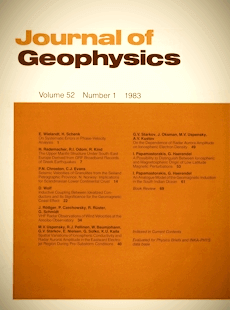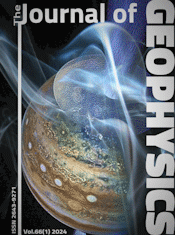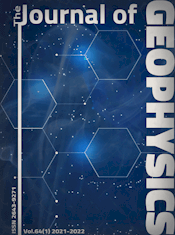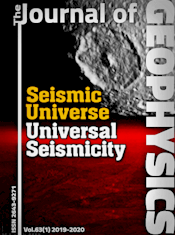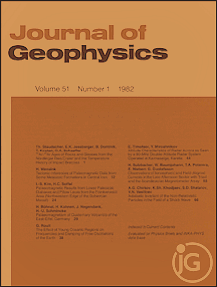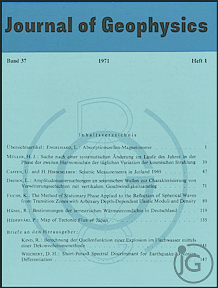Spatial variations of ionospheric conductivity and radar auroral amplitude in the eastward electrojet region during pre-substorm conditions
Article Sidebar
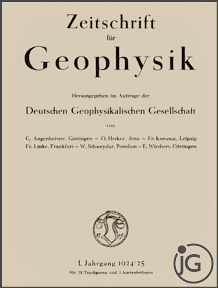
Vols. 1-18 (1924-1944), ISSN 0044-2801
Main Article Content
Abstract
The dependence of auroral backscatter amplitude on different ionospheric parameters (conductivity, current density, electric field) is studied by means of data recorded by STARE (Scandinavian Twin Auroral Radar Experiment), the two-dimensional Scandinavian Magnetometer Array (SMA), and auroral all-sky cameras. The observations were made on 16 March 1978 during pre-substorm conditions in the region of the eastward polar electrojet. The paper shows that in this event the auroral backscatter amplitudes in the 140 MHz frequency band were controlled mainly by spatial variations in the electron density or conductivity inside the back-scatter volume. To a certain extent also a linear relationship between backscatter amplitude and ionospheric current density was found but it is regarded as a special case of a more general relationship between electron density and backscatter amplitude. A stable discontinuity in the Hall conductivity over the most equatorward auroral arc was deduced from the data: On the equatorward side the conductivity was 3-5 times higher than on the nearby poleward side. Our conclusions are discussed in the light of some previously published results on the same subject.
 ARK: https://n2t.net/ark:/88439/y000016
ARK: https://n2t.net/ark:/88439/y000016
Permalink: https://geophysicsjournal.com/article/262
Article Details
References
Balsley, B.B., Ecklund, W.L. (1972) A portable coaxial collinear antenna. I.E.E.E. Ant. Prop. 20, 513-516
Balsley, B.B., Ecklund, W.L., Greenwald, R.A. (1973) VHF Doppler spectra of radar echoes associated with a visual auroral form: observation and implications. J. Geophys. Res. 78, 1681-1687
Baumjohann, W., Greenwald, R.A., Kuppers, F. (1978) Joint magnetometer array and radar backscatter observations of auroral currents in Northern Scandinavia. J. Geophys. 44, 373-383
Baumjohann, W., Sulzbacher, H., Potemra, T.A. (1979) Joint magnetic observations of small-scale structures in a westward electrojet with Triad and the Scandinavian Magnetometer Array. In: Proceeding of the International Workshop on Selected Topics of Magnetospheric Physics, Japanese IMS Committee, ed., pp.49-52, Tokyo
Baumjohann, W., Untiedt, J., Greenwald, R.A. (1980) Joint two-dimensional observations of ground magnetic and ionospheric electric fields associated with auroral zone currents. 1. Three-dimensional
current flows associated with a substorm-intensified eastward electrojet. J. Geophys. Res. 85, 1963-1978
Booker, H.G. (1956) A theory of scattering by nonisotropic irregularities with application to the radar reflections from the aurora. J. Atmos. Terr. Phys. 8, 204-221
Cahill, L.J. Jr., Greenwald, R.A., Nielsen, E. (1978) Auroral radar and rocket double-probe observations of the electric field across the Harang discontinuity. Geophys. Res. Lett. 5, 687-690
Chestnut, W. (1968) Low frequency waves and irregularities in the auroral ionosphere as determined by radar measurements. In: D'Angelo, N. (Ed.) Low frequency waves and irregularities in the ionosphere, pp. 173-191. Dordrecht: D. Reidel
Flood, F.A. (1967) A brief review of auroral backscatter theory. In: McCormack, B.M. (Ed.) Aurora and Airglow, pp. 563-571. Reinhold, New York
Greenwald, R.A., Ecklund, W.L., Balsley, B.B. (1973) Auroral current, irregularities, and luminosity. J. Geophys. Res. 78, 8193-8203
Greenwald, R.A., Ecklund W.L., Balsley, B.B. (1975) Radar observation of auroral electrojet currents. J. Geophys. Res. 80, 3635-3641
Greenwald, R.A., Weiss, W., Nielsen, E., Thomson, N.R. (1978) STARE: a new radar auroral backscatter experiment in Northern Scandinavia. Radio Sci. 13, 1021-1039
Greenwald, R.A. (1979) Studies of currents and electric fields in the auroral zone ionosphere using radar auroral backscatter. In: Akasofu, S.-I. (Ed.) Dynamics of the magnetosphere, pp. 213-248. Dordrecht: D. Reidel
Gustafsson, G. (1970) A revised corrected geomagnetic coordinate system. Ark. Geofys. 5, 595-617
Kamide, Y., Brekke, A. (1977) Altitude of the eastward and westward auroral electrojets. J. Geophys. Res. 82, 2851-2853
Keskinen, M.J., Sudan, R.N., Ferch, R.L. (1979) Temporal and spatial power spectrum studies of numerical simulation of type II gradient drift irregularities in the equatorial electrojet. J. Geophys. Res. 84, 1419 1430
Kuppers, F., Untiedt, J., Baumjohann, W., Lange, K., Jones, A.G. (1979) A two-dimensional magnetometer array for ground-based observations of auroral zone electric currents during the International
Magnetospheric Study (IMS). J. Geophys. 46, 423-450
Kustov, A.V., Pudovkina, E.V., Starkov, G.V., Stepanov, G.S., Suhoivanenko, P.Ya., Uspensky, M.V. (1979) Aurora and radioaurora observations on Feb. 3 and 8, March 15 and 16, 1978 in the framework "Auroral Breakup Campaign". In: Raspopov,O.M. (Ed.) Auroral Breakup Experiment, pp. 3-21. Apatity (In Russian)
Lui, A.T.Y., Anger, C.D. (1973) A uniform belt of diffuse auroral emission seen by the ISIS-2 scanning photometer. Planet Space Sci. 21, 799-809
Lui, A.T.Y., Perreault, P., Akasofu, S.-I., Anger, C.D. (1973) The diffuse aurora. Planet. Space Sci. 21, 857-861
Lui, A.T.Y., Venkatesan, D., Anger, C.D., Akasofu, S.-I., Heikkila, W.J., Winningham, J.D., Burrows, J.R. (1977) Simultaneous observations of particle precipitations and auroral emissions by the ISIS-2 satellite in the 19-24 MLT sector. J. Geophys. Res. 82, 2210-2226
Mareschal, M., McDiarmid, D.R., McNamara, A.G. (1979) Some properties of diffuse radio aurora at high aspect angles. J. Geophys. Res. 84, 6687-6690
Mersmann, U., Baumjohann, W., Kuppers, F., Lange, K. (1979) Analysis of an eastward electrojet by means of upward continuation of ground-based magnetometer data. J. Geophys. 45, 281-298
Moorcroft, D.R. (1979) Dependence of radioaurora at 389 MHz on electron density and electric field. Can. J. Phys. 57, 687-697
Pyatsi, A.Kh. (1974) Auroral radiowave scattering. Radar aurora. In: Brunelli, B.E. (Ed.) High-latitudinal geophysical phenomena, pp. 260-298. Nauka, Leningrad (In Russian)
Siren, J.C., Doupnik, J.R., Ecklund, W.L. (1977) A comparison of auroral currents measured by the Chananika radar with 50 MHz backscatter observed from Anchorage. J. Geophys. Res. 82, 3577-3584
Starkov, G.V., Raspopov, O.M., Uspensky, M.V. (1979) Pre-breakup fading of radioaurora. In: Raspopov, O.M. (Ed.) Auroral Breakup Experiment, pp. 21-38. Apatity (In Russian)
Sudan, R.N., Akinrimisi, J., Farley, D.T. (1973) Generation of small-scale irregularities in the equatorial electrojet. J. Geophys. Res. 78, 240-248
Sulzbacher, H., Baumjohann, W., Potemra, T.A. (1980) Coordinated magnetic observations of morning sector auroral zone currents with Triad and the Scandinavian Magnetometer Array: a case study. J. Geophys. 48, 7-17
Tsunoda, R.T., Presnell, R.I, Leadabrand, R.L. (1974) Radar auroral echo characteristics as seen by 398 MHz phased array radar operated at Homer, Alaska. J. Geophys. Res. 79, 4709-4724
Tsunoda, R.T., Presnell, R.I. (1976) On a threshold electric field associated with the 398-MHz diffuse radar aurora. J. Geophys. Res. 81, 88-96
Tsunoda, R.T., Presnell, R.I., Kamide, Y., Akasofu, S.-I. (1976a) Relationship of radar aurora, visual aurora and auroral electrojets in the evening sector. J. Geophys. Res. 81, 6005-6015
Tsunoda, R.T., Presnell, R.I., Potemra, T.A. (1976b) The spatial relationship between the evening radar aurora and field-aligned current. J. Geophys. Res. 81, 3791-3802
Unwin, R.S., Keys, J.G. (1975) Characteristics of the radio aurora during expansive phase of polar substorms. J. Atmos. Terr. Phys. 37, 55-64
Uspensky, M.V. (1977) Luminosity, radar aurora and ionospheric electrojet structure. In: Loginov, G.A. (Ed.) Structure of magnetic, ionosperic and auroral disturbances, pp. 3-24. Nauka, Leningrad (In Russian)
Val'chuk, T.E., Gal'perin, Yu.I., Crasnier, J., Nikolaenko, L.M., Sauvaud, J.-A., Feldstein, Ya.I. (1979) Diffuse auroral zone. IV The latitude signature of auroral particle precipitations into ionosphere and the plasma sheath structure. Cosmitsh. Issledovaniya. XVII, 559-578 (In Russian)


